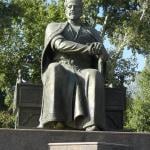
One of my few SBL book picks was Greg Beale’s We Become What We Worship: A Biblical Theology of Idolatry (IVP, 2008). Beale is known for his work on the use of the OT in the New and especially Old in New in the book of Revelation. He would, though, consider himself to be a biblical theologian and has true competency in both testaments. Therefore, he is certainly well-suited to take on this task. Also, he is a committed believer and with a subject like idolatry, he is also capable of addressing modern ‘idolatry’ problems in the church.
The ordering of the book is reasonable enough: after a couple of introductory chapters, he goes on to explore his thesis about the theme of idolatry in the OT, Judaism of the second temple period, the Gospels, Acts, Paul, and the book of Revelation. He, of course, ends with concluding statements, both academically and pastorally.
What is his thesis? Beale is good about stating it repeatedly and in various forms: ‘God has made humans to reflect him, but if they do not commit themselves to him, they will not reflect him but something else in creation. At the core of our beings we are imaging creatures. It is not possible to be neutral on this issue: we either reflect the Creator or something in creation’ (16). And, again, ‘What people revere, they resemble, either for ruin or restoration‘ (16). These statements are supported throughout his theo-exegetical study.
Beale begins in an ostensibly unusual place – Isaiah 6.9-10. I say this is unusual because when people normally argue that we become what we worship they turn to the Psalms (as in Ps. 115:8, ‘Those who make them will become like them’). But, Beale comes to some striking conclusions. If you do not remember, Isaiah 6.9-10 is that tricky passage oft repeated in the NT: Isaiah 6:9-10 And he said, “Go and say to this people: ‘Keep listening, but do not comprehend; keep looking, but do not understand.’ 10 Make the mind of this people dull, and stop their ears, and shut their eyes, so that they may not look with their eyes, and listen with their ears, and comprehend with their minds, and turn and be healed.”
Beale argues that in Isaiah 6.9-13 we have what appears to be ‘a tirade against Israel’s idolatry’ (38). It was a common criticism of idols that they have eyes but can’t see, and have heads but don’t understand. Israel, in trusting in idols, would become like their blind and dumb idols in that their ‘sensory organs are also described as malfunctioning, which revelas that they have become spiritually blind and deaf like their false objects of worship’ (49). I am not able to capture here Beale’s skilled exegesis. Suffice it to say, his arguments immediately convinced me.
Beale also flags up the important episode of the worship of the golden calf (Ex 32). This event had become so characteristic of Israel’s waywardness that much of the later allusive language of idolatry uses bovine elements. Interestingly enough, Beale points to the age-old issue of the translation descrepencies of Habakkuk 3.4: ‘The radiance [of God] is like the light, rays [flashing] from his hand, and there is the hiding of power’. For ‘rays’ the KJV has ‘horns’ as if the rays appeared like two-pronged horns. (Thus, Michaelangelo’s famous statue of Moses depicted with horns – see HERE). If this image is evocative, then whither? Beale says: ‘Could it be that the repeated description of Moses’ “face” as having “had become horned,” after he had come down a second time from Sinai, indicates a parody of the Israelite idolaters, who had come to resemble the calf they had worshiped?’ (80). Brilliant! Beale also concludes that when Israel is accused of being ‘stiff-necked’ – this is the same language used of cattle.
Well, there is no need to progress through the whole book. It is chock full of helpful insights based on his thesis that we become like what we worship, for ruin or restoration.
I did have some concerns with Beale’s interpretation. First of all, he casts his net too wide in terms of the ways in which we become like what we worship. The main ways, negatively, are blindness, numbness, and hard-heartedness. Beale underemphasizes, I think, the limitedness of this conformity. On the positive side (becoming like God/Jesus), there seems to be many more ways in which we can become like God. On a number of small NT texts (especially in Paul), Beale has a tendency to maximalize and see things that I don’t think many others can see. That is always a concern. Also, he doesn’t address well enough the jump or progression from dealing with idolatry in more literal ways in the OT to more figurative ways in the NT and down through the ages. When the ‘idol’ is money (let’s say), how do we ‘become what we worship’? And, I had concern with how wide he cast the net of idol even in Judaism. Sometimes he used texts that refer to evil or ‘Beliar’ or demons to support his thesis (see p. 145).
I must say, overall this is a worthwhile endeavour and I marvel at Beale’s eye for the details. Those interested in biblical theology, ethics, and who just want to see a great interpreter do his thing will not be disappointed.















